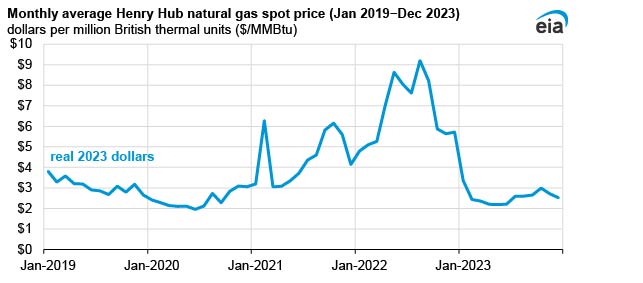
The U.S. benchmark Henry Hub natural gas price averaged $2.57 per million British thermal units (MMBtu) in 2023, about a 62% drop from the 2022 average annual price, according to data from Refinitiv Eikon. Record-high natural gas production, flat consumption, and rising natural gas inventories contributed to lower prices in 2023 compared with 2022. The monthly average Henry Hub price was below $3.00/MMBtu in every month except January, with the lowest monthly average in May at $2.19/MMBtu.
Record-high natural gas production that outpaced growth in natural gas consumption was the primary driver of lower prices in 2023. We estimate that U.S. dry natural gas production averaged a record-high 104 billion cubic feet per day (Bcf/d) in 2023 in our December Short-Term Energy Outlook, 4% higher than the 2022 annual average. Production increased in the Permian region, driven by improved well-level productivity and higher crude oil prices in 2023, as well as in the Haynesville region and the Appalachia region, according to our Drilling Productivity Report.
Warmer-than-average temperatures in January and February 2023—the peak of heating season—led to reduced consumption in the residential and commercial sectors and the lowest total U.S. natural gas consumption for these months in seven years. Temperatures were relatively mild in the U.S. Midwest and Northeast, where 50%–70% of households report using natural gas as their primary space-heating fuel. Mild temperatures also led to lower withdrawals of natural gas from underground storage.
Overall, natural gas demand increased by 3% in 2023 compared with 2022. Increased exports and a slight increase in natural gas consumed for electricity generation offset lower residential and commercial sector consumption. Liquefied natural gas exports rose 12% in 2023 compared with 2022, and natural gas exports by pipeline increased 9% over the same period.

The mild temperatures at the end of the 2022–23 winter resulted in lower withdrawals from natural gas storage than during the previous seven winters, and the United States began the 2023 injection season (April–October) with relatively high storage volumes. Natural gas injections into storage in the summer exceeded the five-year average, and U.S. natural gas inventories at the start of this winter heating season were the highest since 2020.
As a result of production remaining at all-time highs (averaging 105 Bcf/d in the fourth quarter of 2023) and less natural gas consumed in the residential and commercial sectors so far this winter heating season than the previous heating season, working natural gas inventories were 11% above the year-ago level and 10% above the five-year average as of the week ending December 22, according to our Weekly Natural Gas Storage Report.


Follow us on social media: